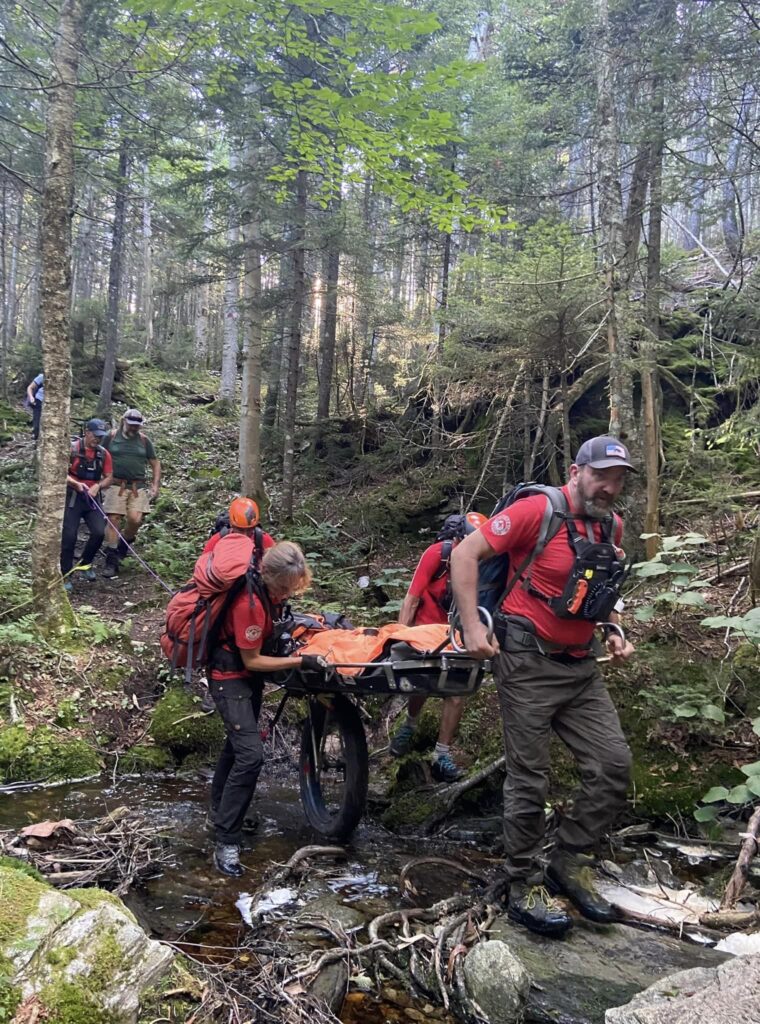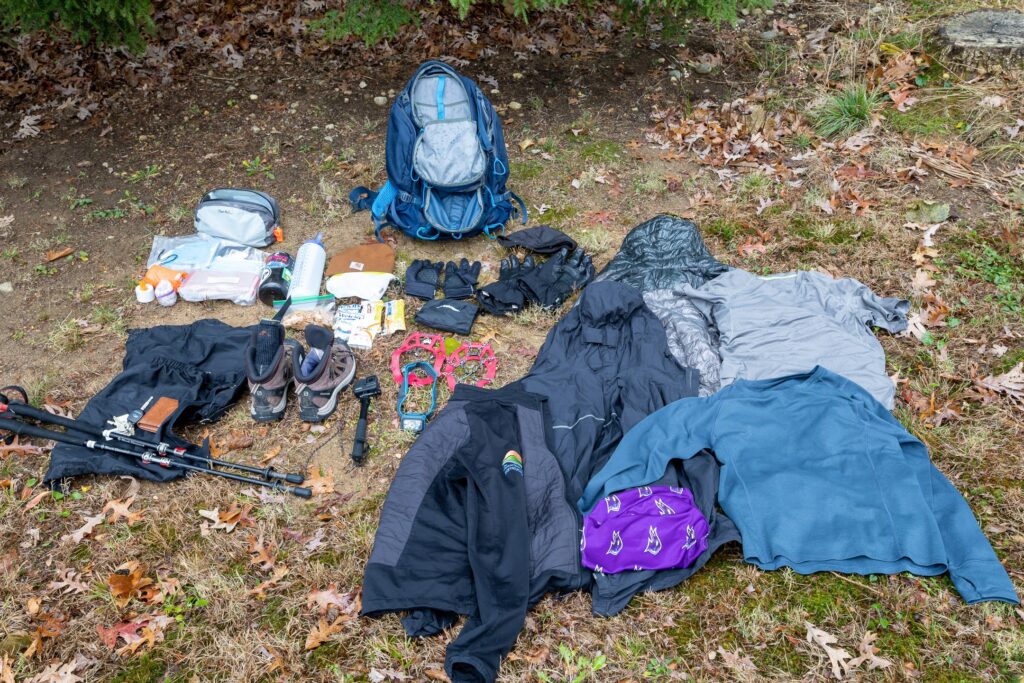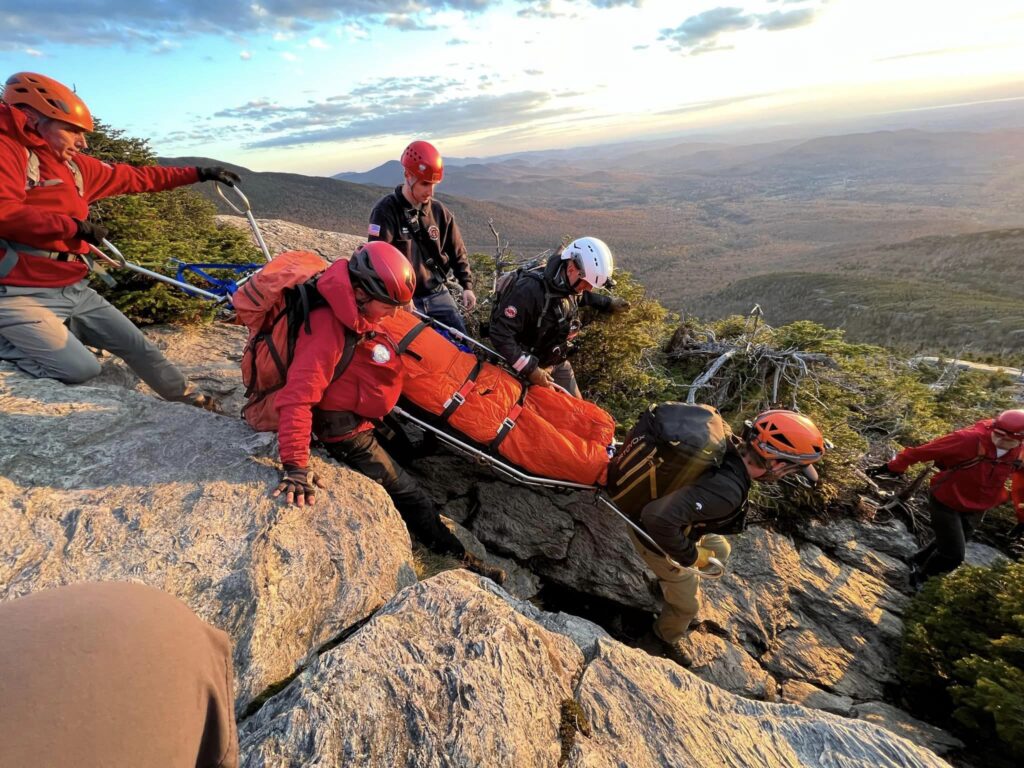This article appears in the Summer 2023 Long Trail News and was adapted from a presentation by Vermont Search and Rescue Coordinator Drew Clymer.
Most of us know and follow routine hiking safety procedures. We understand the importance of hiking in groups rather than alone, and leaving our plans with someone at home, so they can act if we don’t return. But there’s more to know than that.
Drew Clymer, recently appointed Vermont’s Search and Rescue Coordinator, brings a wealth of experience in backcountry emergency response to his new job, thanks to his time with Stowe Mountain Rescue, an all-volunteer organization trained in sophisticated search and rescue techniques often used on the steep, rocky slopes of Mount Mansfield, Smuggler’s Notch, and elsewhere in the state.
Drew recently delivered an outstanding winter Taylor Series talk on the subject for GMC’s Bread Loaf Section that covered the logistics and practices of search and rescue operations in Vermont, and provided practical safety tips for backcountry hikers. He acknowledged that even experienced hikers don’t always take all the recommended safety precautions. That can substantially complicate rescue if it’s needed.
Here is his “Ready for Rescue” plan —steps hikers of any age, ability or experience can take to put rescuers in the best possible position to help in an emergency. It expands upon the HikeSafe Hiker Responsibility Code, which urges hikers to be prepared, stay together, turn back if necessary, be informed about the trail and its conditions, and carry supplies for emergencies.
Pick Your Partners
Many of us love the peace and solitude of hiking alone, or don’t know others who want to hike at our pace or on our schedule. It’s wise to choose solo outings carefully and conservatively, and recognize that hiking in groups is generally safer.
Drew adds these caveats:
Pick your hiking partner(s) thoughtfully. Ask yourself, do we have the same objective? What are the fitness levels in the group? Is everyone willing to hike at the pace of the slowest? What skills and knowledge does the group have? If the answers check the boxes, go with the group, and do not separate. Share knowledge and risk tolerances.
Leave Your Plans
We’ve heard this one often: Tell someone where you are going and when you plan to return. This information can be crucial for search and rescue (SAR) personnel to know where to start and how to search efficiently. Give your emergency contact enough detail for rescuers to avoid wasting time.
- Leave your plan with someone who will notice if you don’t return. As a backup, you can also leave a copy of your plan on your car.
- Be specific. Instead of “I’m going to hike Camel’s Hump,” add details: “I’ll park at the Burrows Trailhead, go up the Forest City Trail, take the Long Trail south to the summit, and return via the Burrows Trail. I plan to start around 9 a.m., and should summit no later than 11 a.m. I plan to get back to my car by 2 p.m.”
- Tell your contact what to expect. Will you check in by text when starting, turning around, or finishing your hike? What time will you be back? (Give yourself a reasonable buffer!)
- Tell them where you’ll park, and describe your car.
- List who is going with you and their phone numbers. If your emergency contact can’t reach you, knowing the other members of your party can be invaluable. Ask your contact to answer calls from unknown numbers, which might be from SAR members.
- Explain what to do if you’re late: try to call you, or failing that, other members of your party. If they can’t reach anyone, drive to the trailhead to check on your car. Ask them to call SAR if it’s still there.
- The call: In Vermont, thanks to Drew and his network, your emergency contact needn’t track down the particular law enforcement or search and rescue agency near you. They can just call 911, and the proper resources and personnel will be mobilized.
OK, I think I need help
Your emergency contact knows what to do, but there are also steps you can take to limit your risk in an emergency. If you’re thinking “I might need help soon,” you definitely do need help. Now. Calling for help early can make the difference between a quick save and a strenuous, hours-long rescue. Experienced hikers may feel embarrassed to call for help, but Drew reminds us: anyone can wander off trail or twist an ankle. And many incidents can be resolved with a simple phone call.

When you call, try to give the operator the information they might need to evaluate the severity of your case. Stay calm, and compose your thoughts before placing a call. You may even want to write down a list of details so you don’t miss one. SAR responders will seek:
- Names and dates of birth of the caller and others in the party
- Number in the party
- The number of a call-back cell phone and its charge percentage
- Location as closely as possible
- Reason for the call
- Weather and terrain where you are
- Preparation and condition of the injured subject (if there is one), and of the rest of the party. For example, if someone has broken an ankle, do they have adequate clothes, food, and water while they await help?
Be Your Own First Responder
It can take hours for SAR personnel to arrive, especially in a very remote location. If it took you two hours to hike in, it’s going to take rescue personnel at least as long, because they will be carrying heavy equipment and it may be dark.
Before leaving your car, make sure you have everything (refer to the “Ten Essentials” as a starting point) to keep yourself and your party safe and as comfortable as possible. This includes spare dry, warm clothing, extra calorie-dense food, water, headlamp (and maybe a spare), first aid kit, and a way to make a fire. Some form of shelter can save lives—a bivy sack, a large contractor’s plastic trash bag, or a lightweight tent without poles. Consider a Wilderness First Aid course to prepare yourself for mishaps.

A note on cell phones
Cell phones can be very helpful, but they are far from infallible. Your carrier may not have service in remote locations, though phones will use any available signal to contact 911. Batteries can drain quickly, especially if it’s cold or if the phone is used for navigation, as a flashlight, or to capture photos and video. You should use other devices for these functions (including a waterproof map!), and keep your phone on airplane mode to preserve its battery for when you truly need it.
Drew also highly recommends personal locater beacons like the Garmin InReach. These GPS-equipped devices do not need a cell signal and can send a preprogrammed message to assuage worries or call for help. User errors have sometimes caused unneeded SAR responses, but Drew and his team still strongly prefer hikers have these life-saving devices.
A few key precautions can improve your chances of a good ending even if something goes wrong. Following the easy steps above will help make you and your group “ready for rescue.”




















Leave a Reply